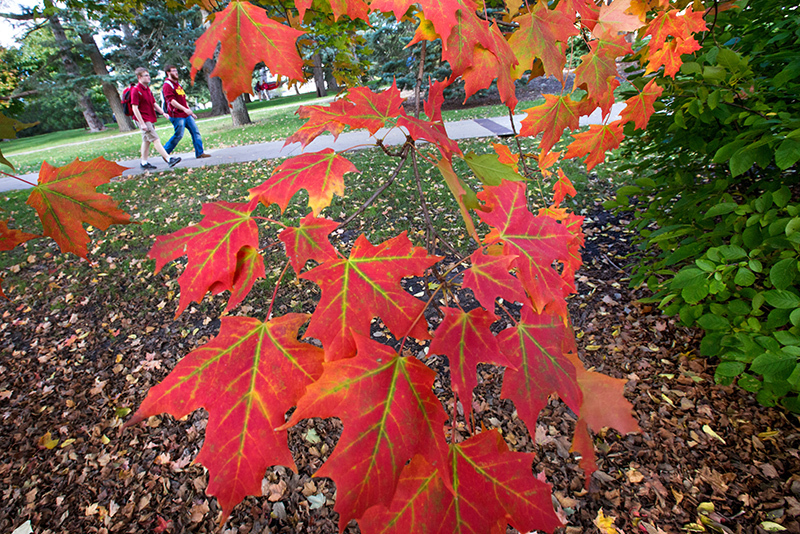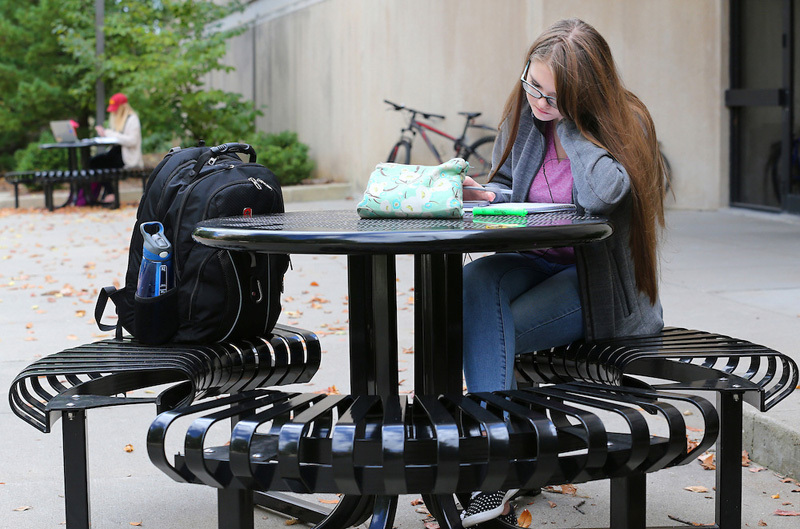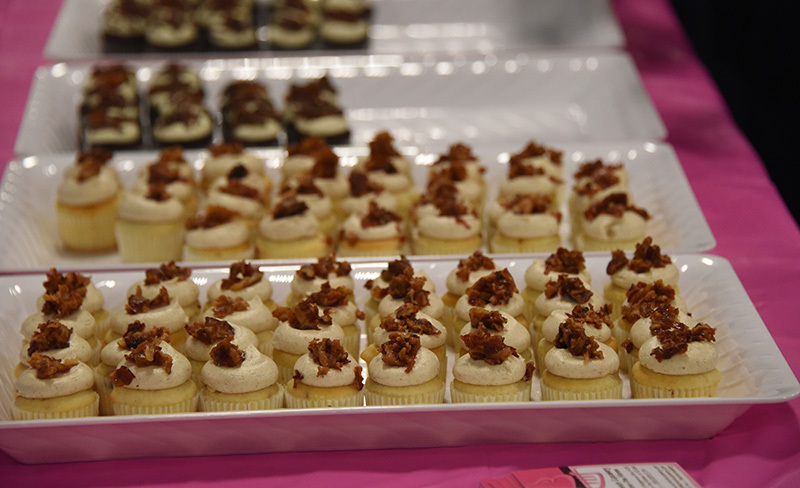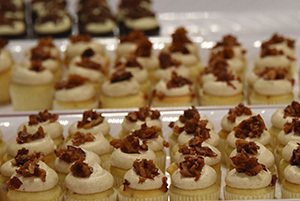Early color

Photo by Christopher Gannon.
Two students walk near some of the early emerging fall colors on central campus this week. These maple leaves were shifting to vivid just southwest of Catt Hall.
Partial shutdown authorized for winter break
Questions?
Contact UHR employee/labor relations staff (294-3753) or your human resources liaison.
ISU administrators have authorized reduced services and limited operations over winter break, a cost-saving effort that has been popular since first implemented in 2009. Although not mandatory, the partial closure allows employees to extend their time off between designated holidays with paid or unpaid leave.
This year, there are four work days -- Dec. 27-30 -- that fall during an 11-day stretch of university holidays and weekends (Friday, Dec. 23-Monday, Jan. 2). In a joint memo to administrators this week, interim vice president for university human resources (UHR) Kristi Darr and senior vice president for university services Kate Gregory outlined procedures for units and employees planning to reduce operations during that time.
"We are encouraging units to begin planning for the winter break period now," Darr said. "We would like to see communication to staff and information placed on websites by the end of October."
Learn more about leave
Employees have paid and unpaid leave options during university academic breaks, but are not required to take leave. Merit employees are covered by the terms in the collective bargaining agreement with the state.
"Deans, vice presidents and leaders are encouraged to review their workloads and enable staff to take liberal leave," Gregory said.
Policies and procedures for the partial closure have been refined for clarity, thanks to a push by the Professional and Scientific Council. In January, the council requested that university administrators take a look at conflicting information in the vacation/leave policies and the flexible hours program.
Since then, UHR staff developed a document of frequently asked questions to provide help for employees and supervisors. Other resources include:
- Staffing guidance for university breaks
- Vacation leave policy
- Office hours policy
- Holidays policy
- Flex time policy
Put a plan in place
Administrators are encouraged to review their activities in advance and work out staffing plans with their employees. Essential services and programs may continue operating, but many will be reduced.
"A partial shutdown isn’t just about making personnel plans," Gregory said. "It’s also about making plans to provide essential services and reduce our facilities costs while maintaining our buildings."
Units that participate in the partial closure also should:
- Communicate staffing plans and operating hours on websites and voicemail inboxes
- Post emergency contact information on websites and voicemail inboxes
- Turn off equipment to conserve energy
- Turn down thermostats for unoccupied spaces
- Check periodically for malfunctions (plumbing, heating, cooling)
- Coordinate staff to monitor and respond to voicemail messages on main numbers
Where to find out more about FLSA changes
University officials continue to work through the details of complying with a change in the Fair Labor Standards Act (FLSA). The FLSA change, which becomes law Dec. 1, sets a new salary threshold for determining which ISU employees are covered by minimum wage and overtime requirements. Generally, those who earn less than $47,476 annually ($913 per week) are covered by the new regulations and will need to record their work time and receive overtime pay for extra hours.
There are exceptions to the FLSA rules, and officials in university human resources (UHR) and the office of university counsel are working to determine who's covered (nonexempt) and who's exempt from the rules. UHR's Fair Labor Standards Act website contains more information about the new regulations and answers to frequently asked questions. The site will be continuously updated over the next few months.
Leath announces $1.1 billion campaign
President Steven Leath announced the launch of the "Forever True, For Iowa State" campaign, a historic initiative to raise $1.1 billion for the university by June 30, 2020. The announcement was made at a Sept. 30 event in Hilton Coliseum.
The goal is the largest ever for a comprehensive ISU campaign, and will help achieve the university's vision to lead the world in advancing the land-grant ideals of putting science, technology and human creativity to work. The campaign goals include funding for research, faculty, student scholarships, new facilities and innovative programming, among others.
"One of Iowa State’s greatest resources is its family of loyal alumni and friends," Leath said. "This degree of loyalty is why the name of this campaign feels so appropriate. Our alumni remain forever true to this university -- as Iowa State remains forever true to the principles of innovation, diversity and accessibility on which it was founded."
With a name inspired by the Iowa State fight song, the campaign will rally support for scholarships, faculty support, facilities and programs. It will help ensure access to an exceptional education, advance Iowa State expertise in key areas that address global challenges, and enhance the university’s impact on the economy and quality of life in Iowa and around the world.
"I invite everyone whose lives have been touched by Iowa State to consider what it means to be Forever True to this university," said Jon Fleming, a 1975 Iowa State graduate and retired gastroenterologist from Ames, who serves as campaign chair. "With the help of our extended Iowa State family, I know we can make this the most transformative campaign in Cyclone history."
Off to a good start
Since the campaign began its quiet phase in 2012, more than $551 million has been raised and already is making a difference on Iowa State's campus.
The Moving Students Forward initiative, launched in 2012 by Leath, raised $204 million specifically for scholarships and other student support. More than 23,000 students have received support through the initiative. Also during the campaign to date, 35 new named faculty positions have been created. The Marston Hall renovation and the addition of the south end zone of Jack Trice Stadium were completed, in part, with funds contributed during the quiet phase.
"This goal stretches us, but there is so much to be gained in meeting it for our students' and for our children's futures," said Larissa Holtmyer Jones, president and CEO of the ISU Foundation.
Have a seat

Tables installed on campus this fall offer additional spots for Iowa Staters to work, study, eat and relax. Photo by Christopher Gannon.
Thanks to surplus funds in student government's coffers, faculty, staff and students have several new places to perch on campus.
Student government initiated a bill last spring to purchase sturdy outdoor tables and chairs that Iowa Staters can use for studying, eating lunch or simply relaxing. The bill passed and student leaders earmarked $115,000 for new tables. Installation began in August and, so far, 26 tables have been installed with more to come.
The black, metal tables with attached benches offer picnic-table-style seating and accommodate four to six people comfortably. Of the 26 tables, 22 are round and four are oval. Five of the round ones are equipped with a metal umbrella and bolted to the ground. The others tables are moveable, though their hefty weight of about 300 pounds makes it unlikely they will "walk" -- or blow -- away.
"We needed to keep the tables moveable to make clearing snow easier for facilities planning and management staff in the winter," said Rhonda Martin, landscape architect.
Martin added that FPM would enlist the help of skid loaders to move the tables when necessary.
Table locations
FPM placed the tables in certain locations based on several factors, according to Martin. They needed to be installed where there was pavement, a need for seating and where they wouldn't block pedestrian traffic.
The umbrella tables are east of the Durham Center. Other tables purchased by student government were placed in these locations:
- College of Design, east side
- Human Nutritional Sciences Building, west side
- Sweeney Hall, northwest corner
- Durham Center, northwest corner
- Howe Hall, east side
- Hoover Hall, west side
- Black Engineering Building, northeast corner
- Beardshear Hall, south side
- Between Carver and Music halls
Additional tables
The colleges of Agriculture and Life Sciences and Business also purchased tables for use outside Curtiss Hall and the Gerdin Business Building, respectively. Four tables are located east of Curtiss and one is east of Gerdin.
Other colleges and units interested in purchasing tables should contact Martin at rhjmarti@iastate.edu or 294-9885. Tables run between $1,500 and $2,500; umbrellas are an additional $2,700.
Earlier FAFSA timeline is intended to inspire wise college choices
After decades on the same timeline, the student financial aid application process, beginning with the 2017-18 academic year, has jumped ahead -- by three months. The U.S. Department of Education's Free Application for Federal Student Aid, or FAFSA, became available on Oct. 1, and Iowa State is among the schools that set a Dec. 1 priority deadline to guarantee consideration for university grants, some scholarships and federal loans and work-study funds. For years, those dates were Jan. 1 and March 1, respectively.
Speaking last week at her office's annual update for the campus community, student financial aid director and 30-year student aid veteran Roberta Johnson called it a "seismic change of epic proportion."
Reminder items faculty/staff may download are on the Early FAFSA website.
The intent, she said, is to give students and families more time to consider their options and make a sound choice on a college. While the college search and application process begins earlier in students' high school careers, the financial aid piece has lagged behind, sometimes arriving too late to truly be part of the decision.
Under the [former] March 1 FAFSA filing deadline, Iowa State's award letters didn't go out until the end of March, Johnson said. By then, students may be too emotionally invested in their school of choice to be dissuaded by financial aid and cost-to-attend realities.
"The Department of Education sees this change as a financial literacy thing, that students will make wiser financial decisions about where they're going to school," Johnson said. "Letting students know earlier what resources will be available to pay for college is critical. This enables several months of conversations (Feb. 1-May 1) with those families we couldn't have before."
Johnson said a related goal is to help reduce the amount of borrowing students take on to pay for school.
Iowa State uses a rolling admission process, with would-be freshmen receiving a response to their admissions applications within two business days. Nationally, May 1 is the date by which many schools ask their pool of accepted students to accept or decline the offer. Iowa State uses it as the refund deadline for students who earlier accepted an admissions offer and change their minds.
Spread the word, please
Johnson asked faculty and staff to help spread the word about the new FAFSA timeline to their students, but also to friends, neighbors and relatives who have, or next year will have, children in college. Two audiences she's especially concerned about reaching are:
- Families whose first child will enter college in the fall of 2017 and who may not be far enough along in their college search to be informed about the financial aid application process
- Families who haven't had a college student for a year or two and who think they know the drill -- but don't, if they're operating on the old FAFSA timeline
On its Early FAFSA website, the student financial aid office offers promotional items faculty and staff can use to help spread the word. These include small posters, an informational "cheat sheet" and other suggestions. Office staff also will hold 10 more "File Your FAFSA" days in 0210 Beardshear through mid-November to help current ISU students begin their FAFSA applications. The remaining sessions are:
- 8-11 a.m.: Oct. 14, Oct. 17, Nov. 1
- 9-11 a.m.: Nov. 7
- 1-4 p.m.: Oct. 11, Oct. 24, Nov. 15, Nov. 16
- 2-4 p.m.: Oct. 19, Nov. 10
For the 2014-15 academic year, 75 percent of Iowa State's undergraduates filed a FAFSA and about three-fourths of applicants showed financial need.
Making FAFSA easier
Two other changes that take effect this fall are intended to improve the FAFSA application's reputation for being a laborious effort:
- Families will use income information from a year earlier than in the past. For example, FAFSA applicants for the 2017-18 school year will provide their 2015 data, which was due to the IRS on April 15, 2016. This is intended to cut down on FAFSA application delays because families haven't filed their tax documents yet. Families experiencing significant income swings during the two years can report this through a special review.
- The FAFSA document contains a data retrieval tool that will import relevant income information from the Internal Revenue Service. Johnson expects that most families will be able to use this tool, though not all. For example, filers with amended tax returns (1040X) won't.
What happens after Dec. 1
Families with students applying to college still may file their FAFSA after Dec. 1, but the "free" money -- grants and scholarships -- gets awarded quickly. Johnson said her target date to start mailing award letters to incoming freshmen (those who have applied and been accepted) is Jan. 28, 2017. She recommends that departments adopt a Dec. 1 or Jan. 1 application deadline for their scholarships to be included in the award letters. The ISU Foundation's scholarship projection report for 2017-18 also will come out earlier this year, sometime during the first week in November, Johnson said.
Fall 2017 incoming transfer students will receive their award letters from Iowa State in early March and returning students by mid-April, she said.
Saturday brunch: Bacon

Photo by Barb McBreen, Agriculture Communication Services.
Tickets still are available for Iowa State's 4th annual Bacon Expo on Saturday, Oct. 8 (11 a.m.-2 p.m., Hansen Agriculture Student Learning Center), hosted by a student committee in the College of Agriculture and Life Sciences. Among other treats, try bacon jalapeño poppers, maple-frosted cupcakes topped with bacon (pictured), bacon gelato and more. The event also features live entertainment and educational exhibits about Iowa's pork industry. Tickets are $12 in advance via Midwestix or $15 at the door. A portion of proceeds will be donated to the Learning Disabilities Association of America, the committee's charity of choice.

